Motorhome water systems: everything you need to know
On-board water is an important part of every motorhome – here’s everything you need to know
Most motorhomes will have a built-in fresh water tank and a waste (grey) water tank. The fresh water tank will serve the kitchen sink and, if fitted, the washbasin and shower as well as the toilet’s flush (although a few vehicles have loos that have their own reservoir for flush water).
A separate switch on the motorhome’s control panel will isolate the water pump and, when this is switched on, water will flow as soon as a tap or showerhead is turned on.
Most models will also have a hot water system, with a boiler heated by either gas or diesel (and often 230V, too, when you’re hooked up). Some motorhomes will have an external shower (sometimes cold water only), which is useful for washing down pets or boots.
When choosing a new motorhome or campervan it’s important to consider the size and location of the water tanks, as well as the type of hot water system used.
Page contents
- How do motorhome water systems work?
- Main components of a motorhome water system
- How to fill and empty the water in your motorhome
- Driving your motorhome with fresh water on board
- How to clean a motorhome water system
- Maintaining your water system in winter
- Common issues with motorhome water systems
- About our magazines
Words by Iain Duff
How do motorhome water systems work?
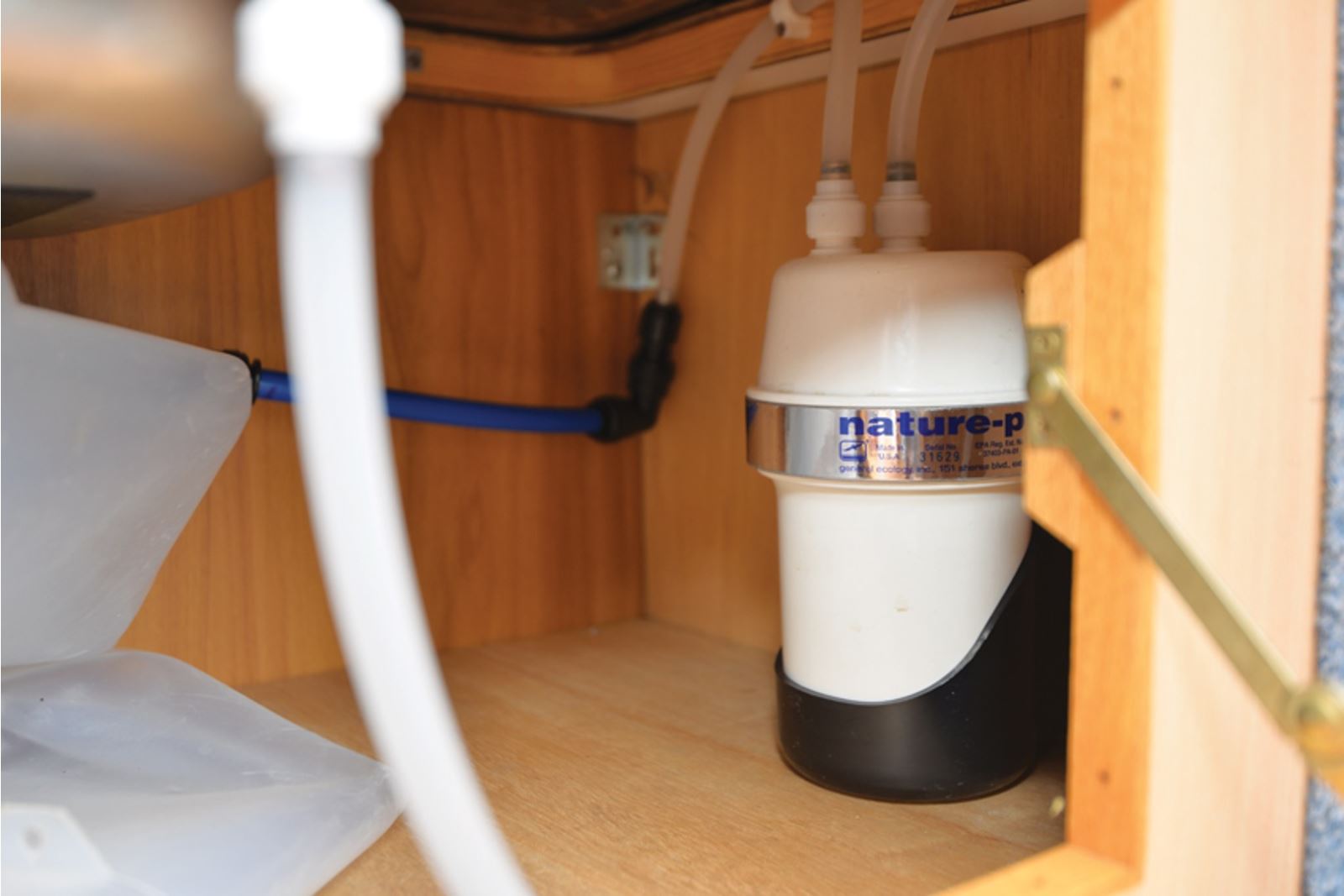
(Photo by Peter Rosenthal)
Most motorhomes and campervans have a fixed fresh water tank that’s filled up by physically moving the vehicle to within a hosepipe-filling length of a water tap.
The fresh water tank is connected to a pump and series of hoses and taps, as well as feeding the hot water tank (often built into the heating system with a Truma Combi unit).
When you open a tap, the pump is activated – either via a pressure switch or a microswitch in the tap body – and water flows.
It exits back through the vehicle’s plumbing into a grey waste water tank, which can then be drained by driving over a suitable drainage point on a campsite and emptying it.
Some smaller campervans will instead have portable water carriers which supply water to the sink and are simply removed from their cupboard and carried to a tap for refilling. These containers usually contain around 10 to 12 litres and some campervans will have two, so when one runs out you swap them over.
Not all small campervans will have a waste water tank, in which case you’ll need a receptacle (ideally a folding one) to catch grey water as it flows out of the sink to a pipe under the campervan.
A few European A-class motorhomes and most American RVs can also have a black waste water tank that’s connected to the toilet sewerage system, rather than a toilet cassette.
Black waste needs to be emptied out at a campsite that has a specific black waste dump point, so many owners add a macerator, which allows them to dump black waste at a normal waste empty point (with the campsite owner’s permission).
Main components of a motorhome water system
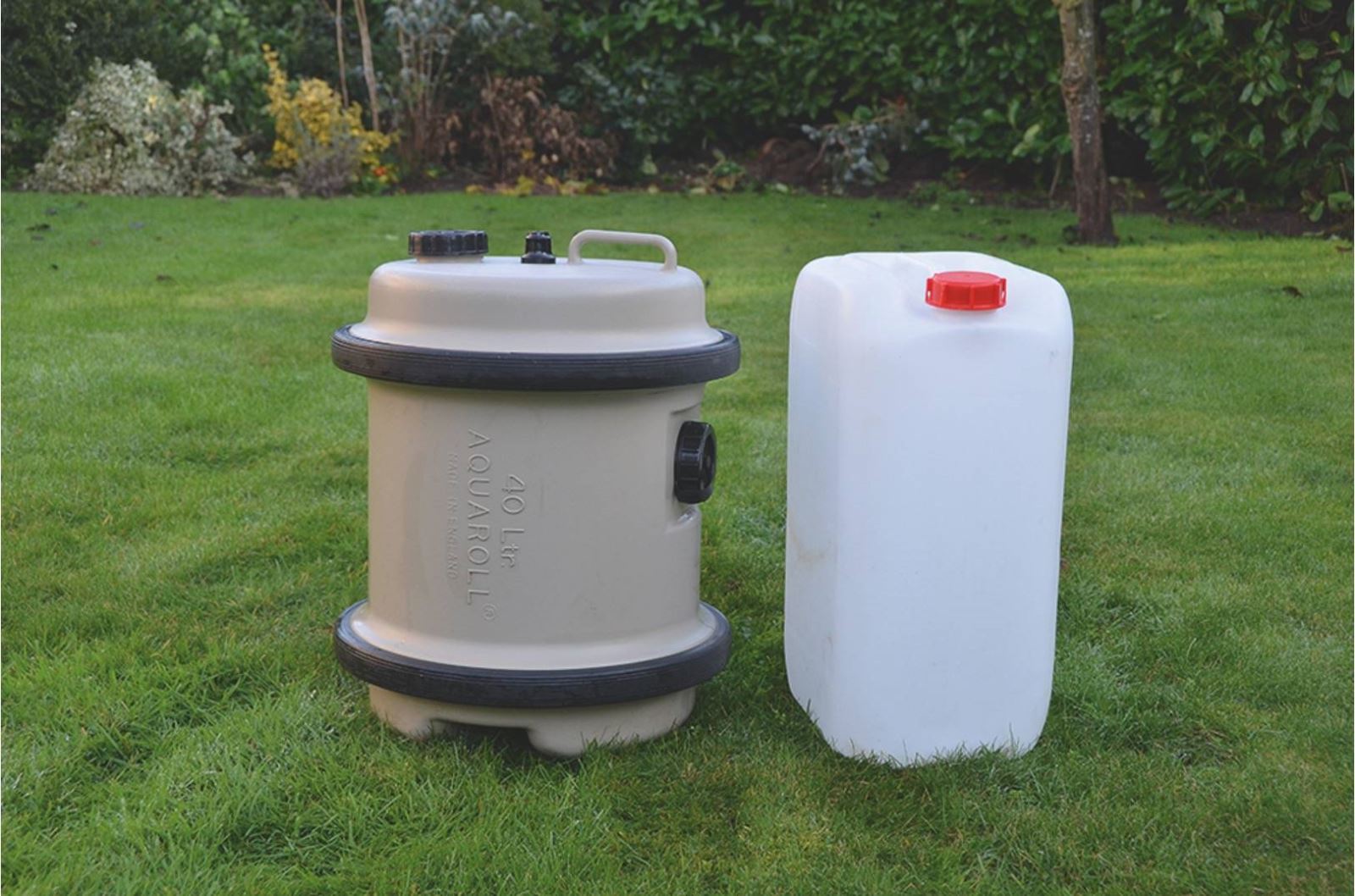
(Photo by Barry Norris)
The placement of the fresh water tank depends upon factors such as the size of the vehicle, its layout and axle load limits.
Most coachbuilt motorhomes and larger campervans made in Europe have a fresh water tank inside the habitation area – often under the rear travel seats – where it can be centrally located for weight distribution and proximity to all the taps. The closer the water tank is to the taps, the less plumbing and connection points are needed. Being inside the habitation area means the water is unlikely to freeze and will be better insulated from the elements as it sits on top of the thick insulated floor.
Some vehicles, however, including a number of British-built coachbuilt motorhomes and smaller campervans, have the fresh water tank underneath the floor of the vehicle (often referred to as underslung). This is fine most of the year round in the UK. However, if you enjoy winter holidays, then make sure there is suitable insulation as well as a heating element for the tank. These tank heating elements can be retrofitted but they are not as ‘winterproof’ as an inboard tank; we have experienced heated underfloor tanks freezing in a British winter when it was around minus six degrees overnight.
The considerations for waste water tanks are similar to those for fresh water tanks, but grey waste tanks are much more likely to be fitted underneath the vehicle, so will be at greater risk of freezing. Look for models with an insulated and/or heated waste tank if you like touring in colder weather. Note, too, in winter many motorhomers leave the waste drain tap open and use a bucket for the waste water to drain into (it’s the tap, rather than the tank, that’s most likely to freeze up).
Most motorhomes use one of two kinds of water pump. Pressure-activated pumps are switched on when their pressure sensor detects a drop in water pressure when a tap is opened or the loo flushed. These are often external to the fresh water tank and the pressure sensor is adjustable.
The other common type of water pump is one triggered by on/off microswitches located in each tap. These can be mounted externally near the water tank or submersed in the tank itself.
If you have a small campervan without a shower, then your water requirements will be quite low and a removable tank of around 20 litres may suffice. Removable tanks are easier to clean and fill up. In winter they can be removed to reduce the chance of freezing.
In a coachbuilt motorhome you should, ideally, be looking for at least 100 litres of fresh water capacity and nearly as much for waste. Some large A-class models can carry as much as 250 litres of water. If you plan on regularly using the shower in your motorhome, look for the models with the biggest water tanks but also shower carefully, switching off the water while you apply gel and shampoo, for example.
The best method of installing water tanks is to sandwich them between a heated double floor system and this is the method employed by most high-end motorhome manufacturers. It eliminates most freezing issues and protects the tanks from road debris, too.
All the pipes in a motorhome’s water system will be food-grade plastic and blue or red tubing, denoting cold and hot respectively, or clear piping striped with red or blue flashes. Most modern models use semi-rigid hose and push-fit connectors that are similar to some domestic systems. Any plumbing that runs externally should be insulated, which isn’t always the case with waste water plumbing.
How to fill and empty the water in your motorhome
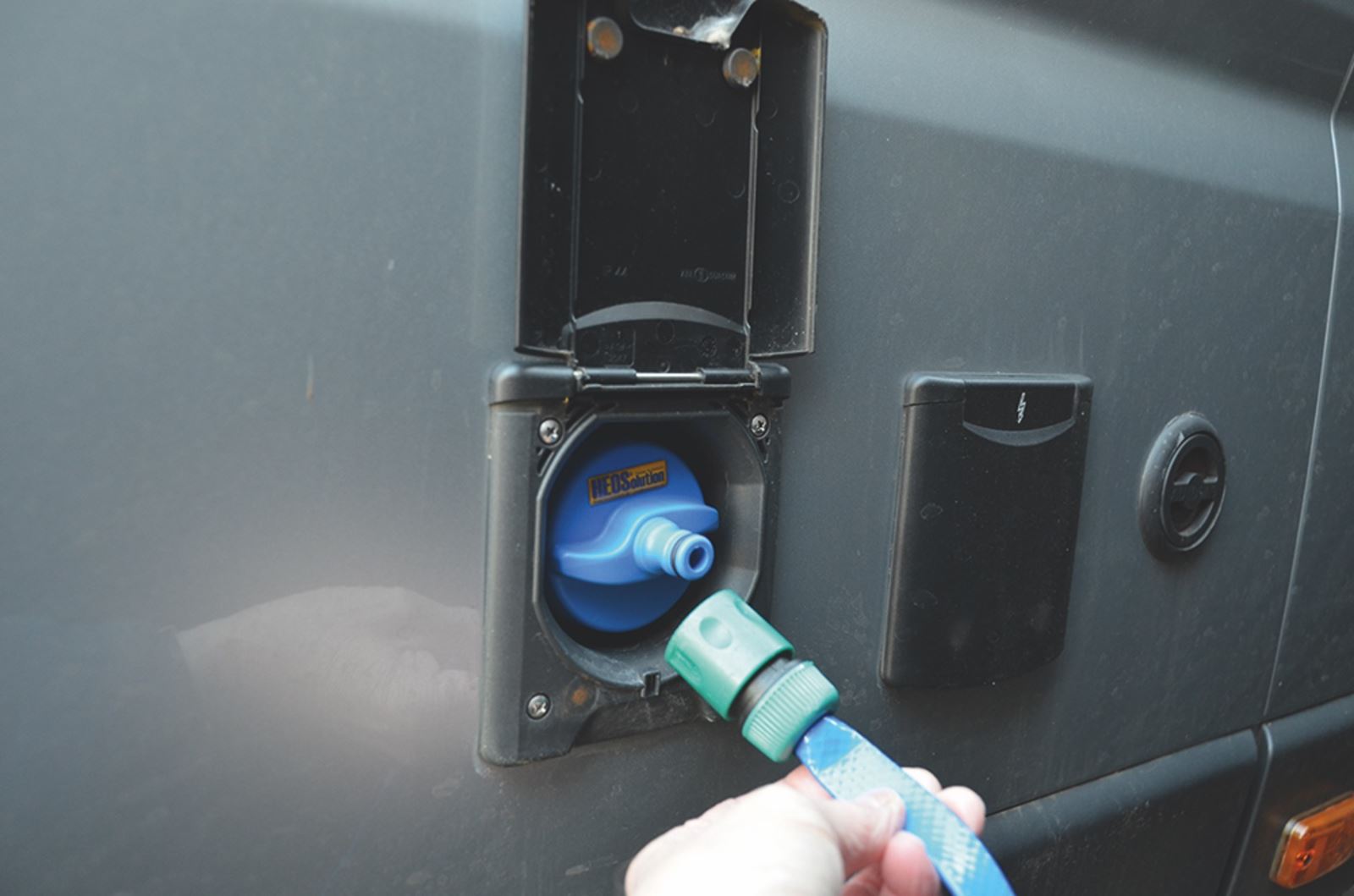
(Photo by Barry Norris)
Filling up with fresh water and emptying (grey) waste water is easy. Most good campsites provide motorhome service points where you can park adjacent to a fresh water tap and drop your grey water directly into a drain. Super pitches are also becoming popular where each pitch has direct access to water and drainage.
In these situations, the first essential is a length of hose to fill up the tank. Don’t be tempted to use a garden hose as this is likely to taint the water because chemicals can leach out into the water. A food-grade hose uses materials that won’t taint water and will discourage the build-up of biofilm on the pipe walls.
Some motorhomers also carry a portable jerry can to top up with water without moving the vehicle off its pitch, however this can be laborious and time consuming. If you want to do this, use a container made of food-grade plastic.
If you’ve previously had a caravan, you might be tempted to use an Aquaroll, which is usually an essential accessory with a touring caravan. However, they are extremely bulky to store and not really necessary with a motorhome, which will have a built-in water tank. Pouring water from a large container into the filler in the side of your motorhome is not easy, either, and you will probably need a submersible pump and hose to do this (some models have a 12V input near the fresh water filler for this purpose).
Emptying your waste tank should also be simple but this is where motorhomes differ in their practicality. Some have small, fiddly taps and grey water will dribble out slowly. Others have larger bore waste pipes and wider outlets for emptying grey waste, sometimes even with an electrically opened valve, for much faster draining of waste water. A few luxury models even have a camera system that allows you to see that your emptying valve is over the waste drain without leaving the cab! Some motorhomes also come with a clip-on extension hose for draining down when you can’t get as close as you’d like to the emptying point on the campsite.
Driving your motorhome with fresh water on board
You should empty your waste water tank before leaving the campsite, but you’ll usually want to drive to your next destination with at least some fresh water on board, otherwise you won’t be able to wash dishes, take a shower, flush the loo (usually) or even make a cup of tea! Just don’t leave water on board when not using the vehicle as it will soon become undrinkable.
Remember that one litre of water weighs one kilogram (1kg), so a typical 100-litre fresh water tank filled to capacity takes out 100kg of your payload as most motorhome payloads are calculated either with no fresh water included (typical for UK brands) or only 20 litres (most European models). Some motorhomes have a travel position on their fresh water tank which will drain it down to this smaller amount.
In many cases, you won’t have sufficient payload to drive with a full water tank and it’s important to remember that an overloaded vehicle is illegal and could invalidate your insurance. If in doubt, take your vehicle to a weighbridge.
How to clean a motorhome water system
A water supply system, which does not have a regular turnover of water, will develop a biofilm on the internal surfaces of pipes and tanks. Added to this it’s likely when using hard water there will be a build-up of limescale in the system. Fortunately, easy-to-use products are readily available to descale and sterilise your system to keep you safe.
Descaling – Truma recommends descaling a Combi boiler at least twice a year. Filling up the fresh water tank, pipework and hot water boiler with food-grade citric acid in solution in accordance with the manufacturer’s recommendations will dislodge limescale and other debris, including biofilm, along the pipework.
Elsan’s Fresh Water Tank Cleaner combines citric acid with cleaning agents and a product to inhibit the growth of bacteria and is marketed as an all-in-one descaling and sterilising agent.
Sterilising – Many sterilising agents contain chlorine, which is an effective sterilising substance but is corrosive to stainless steel, a material found in many motorhome hot water boilers. Certainly, use inexpensive chlorine-based baby sterilising fluids or tablets for your portable and underslung tanks. But do not switch on your pump to lift the sterilising solution into the motorhome pipework system and hence the water boiler. For whole system sterilisation use products made for the leisure market that clearly state the ingredients do not contain chlorine.
Additives – Elsan (of toilet fluid fame) claims water treated with its Elsil product will remain drinkable for several weeks. With an increased dosage, Elsil and other products can be used for making water, which is likely to have been contaminated, safe.
It’s always a good idea if you tend to do all your filling and emptying at the same time, to start with collecting your fresh water supply (with clean hands) and then progressing to grey water disposal and subsequently cassette emptying duty. Regular hand washing and care on how you deal with fresh and waste water should eliminate the risk of contamination.
You will rarely find a water filter fitted as standard in a motorhome (Knaus vehicles are an exception), but these can be added as an aftermarket accessory. These are the various types of filter:
Grit filter – These use a metal screen to strain out grit in the water before it enters the pump. They don’t perform any water quality function.
Microbiological purifier – Often found on canal boats, they are ideal for motorhomes. They claim to be able to change virtually any non-salt water into drinking-quality water. You are looking at around £300 for a system with a separate tap plus fitting costs and cartridge replacement costs of around £80.
Maintaining your water system in winter
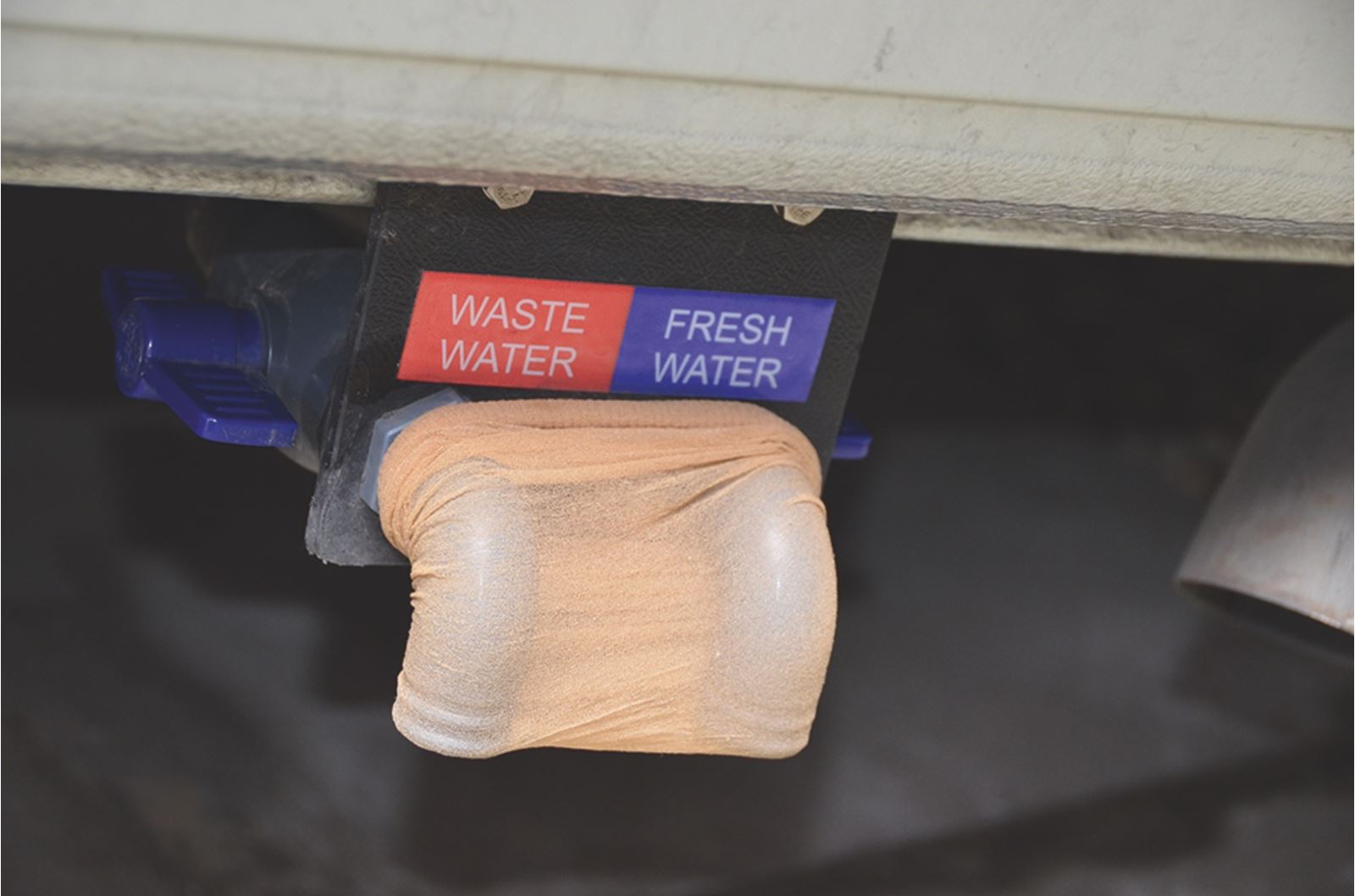
(Photo by Barry Norris)
As we’ve already pointed out, water tanks should be inboard if you’re planning to do much winter camping in sub-zero temperatures, such as on a skiing trip or even in Scotland or the Lake District out of season. Even heated underslung tanks (and especially waste taps) can freeze up in really cold conditions. An external tank with insulation but without a heater can exacerbate the problem, too, as the insulation can increase the time required for the tank to thaw out.
Waste tanks are often best left with the outlet valve open to drain into a portable tank. Last thing at night, pour salty water down the kitchen and washroom waste to discourage any water trapped in external pipework from freezing on colder nights. Have a small water container that is available for collecting water from indoor taps when all the external campsite taps freeze up.
Most modern motorhomes have temperature-activated valves that automatically drain off the hot water tank in cold conditions and, if the pump is switched on, these will then drain the fresh water through the boiler. These work well, but don’t rely on them.
Even if the tank drain valve has emptied the water tanks that doesn’t mean the motorhome is fully frost protected – any part of the system where water can be trapped (between the water pump and kitchen tap) can cause an issue. As water freezes it expands and can split the housing it is contained in.
Read the owner’s manual for the correct winter drain-down procedure for your vehicle. Most involve opening the drain valve in the fresh water tank and the waste water tank, as well as opening up all the sink taps and shower taps. Then run the water pump until you hear it running dry (then switch it off immediately). You can also buy air bleed valves that allow you to evacuate all water out of the system using compressed air. Remember to remove any water filter system parts over winter, too.
To recommission the system, close all the drain valves, switch off all the taps and refill the water tank. Then open the tap furthest away from the water tank and keep it open until it gives a steady flow. Repeat this procedure for each tap and the showerhead. Most water pumps will self-prime very easily.
Common issues with motorhome water systems
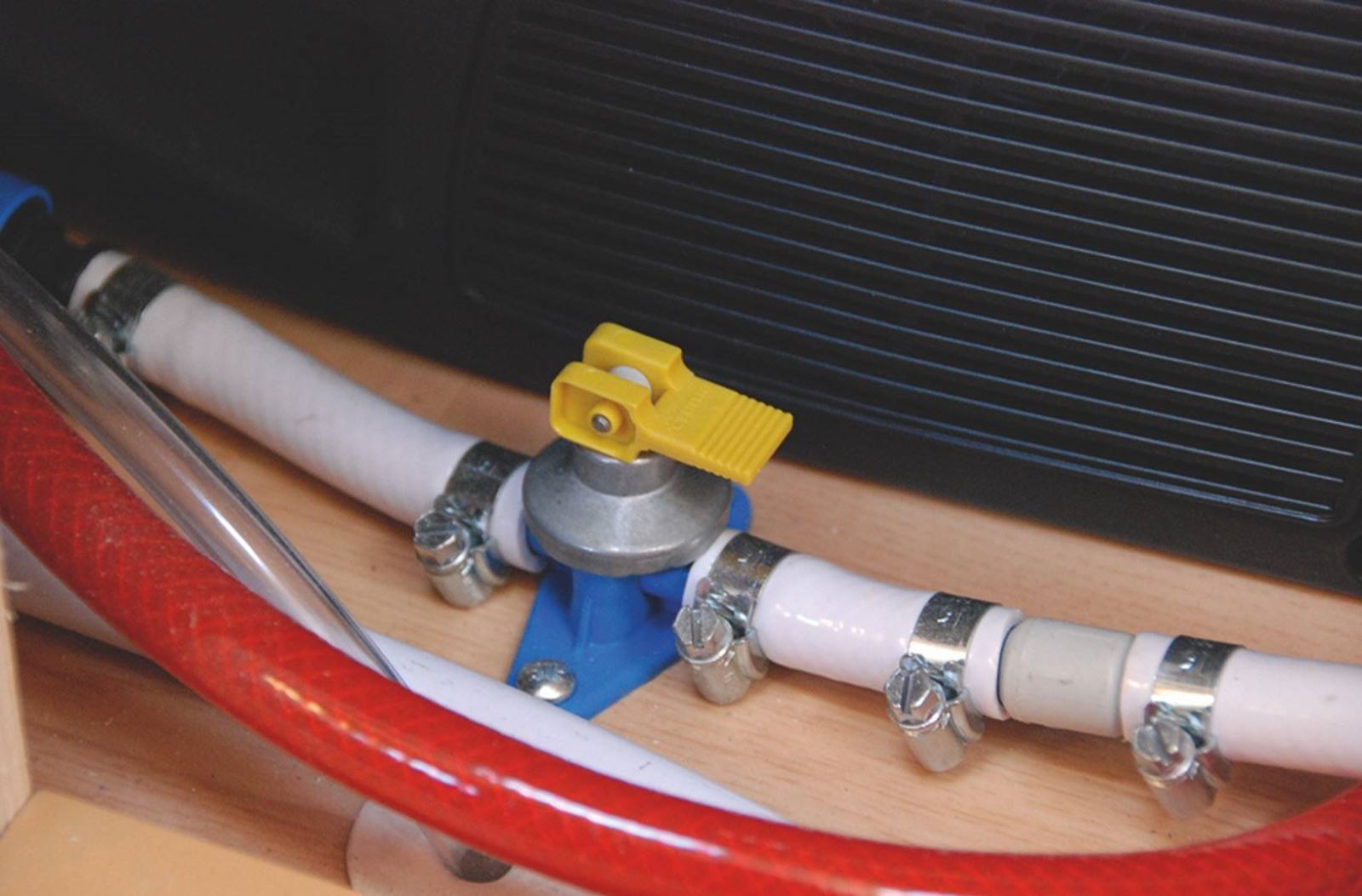
(Photo by Barry Norris)
#1
Everything that goes down the plughole from your washbasin, shower tray and kitchen sink, will go into your waste tank and, if this isn’t cleaned, it can start to smell, with the pong coming up into the living area.
To avoid this, try to stop food debris, etc, going into the tank but you’ll also need to periodically clean the waste tank. Most motorhomes should have an access panel in the tank to enable this. An affordable and practical product to do this job is Thetford’s Tank Freshener.
#2
Pressure-activated water pumps are generally reliable but be aware that, if you have a water leak, they can activate automatically and pump water out of any hole or detached hose connector. Draining down over winter, and switching the water pump off when it’s not in use can prevent this.
The tell-tale sign of a water leak (or a failing water pump pressure switch) is if the pump keeps switching on and off when no taps are open. If a water pump does this, try adjusting the pressure valve to see if it stops the pump actuating. If it doesn’t and you’ve checked for any leakage, then suspect the pressure switch.
#3
Water pumps are generally reliable, but the microswitches on the taps can fail. If the water pump works on the kitchen tap, but not on the washroom basin, then it suggests the washroom tap has failed or has a wiring issue.
It’s easy to check if a microswitch tap works with a multimeter. Set the multimeter to its continuity setting and connect its probes to either end of the two wires coming out of the tap. If the meter doesn’t beep or indicate a connection when the tap is opened, the microswitch has failed and the tap will need replacing. Taps are generally easy to replace, but this depends on the access underneath them.
#4
Any underslung water tank is also more prone to damage than an internal tank, so they need to be checked regularly for leaks or damaged piping.
Expert motorhome advice to your door!
Why not subscribe to one of our fabulous magazines and get expert advice, travel ideas, technical help and all the latest news for your motorhome and your motorhome adventures!

Want to know more about MMM magazine?
Every month MMM has articles written by motorhomers who have been there and done it, from great UK and European (and further afield) tours, campsite reviews, owners' reports and DIY projects among other things.
MMM's tests, reviews and expert buying guides are not to be missed. MMM's technical advice is a must and includes everything from weekend jobs to longer-term DIY projects. And much more!
About MMM magazine
Want to know more about What Motorhome magazine?
Every issue of What Motorhome magazine provides essential buying advice for anyone looking to buy a new motorhome or campervan or upgrade their existing model. With a pedigree of over 30 years of offering the best motorhome and campervan buying advice, every issue of What Motorhome includes more new motorhome and campervan reviews than you will find in any other magazine.
About What Motorhome
Want to know more about Campervan magazine?
Campervan is the exciting monthly magazine that will give you all the inspiration you need to explore the world in your campervan. Every issue is packed with real-life campervanning experiences, inspiring travel ideas in the UK and further afield, the best campsites to stay on, campervan road tests and reviews of the latest models, and much more!
About Campervan magazine







Recent Updates
Engine management lights: all you need to know
What is the engine management light? What does it mean, and what do I have to do? ...
Motorhome air suspension: all you need to know
Motorhomes are heavy and the additional weight of equipment and height of the bodywork can increase the loads ...
Motorhome WiFi: how to get better motorhome internet
Staying connected on the move is more and more essential, so relying on campsite WiFi isn't an option – here ...
A class of their own - our guide to A-class motorhomes
Thinking of trading up to an A-class, or even going straight to the top of the motorhome tree? We guide you ...
Explore overseas on a motorhome dream tour
Enjoy exotic travel in a campervan or motorhome by hiring, swapping with someone else or exporting your ...
Campervanning in Europe: what you need to know
Whether you're planning a leisurely drive through the French countryside, navigating bustling city streets in ...
Campervan security: all you need to know
With thefts on the increase, it’s important to know how to keep your campervan secure and prevent campervan ...
Campervan furniture: everything you need to know
Our campervan experts guide you through all the essentials for your campervan, including tables, chairs, ...
Campervan finance: how to fund your purchase
Here we look at the different types of campervan finance available, to help you decide what’s the best option ...
Britain’s best used motorhomes
Want a great motorhome without paying the premium for a new one? Here's a guide to the best you can get in ...
Other Articles
Which motorhome? Choosing the perfect motorhome for you
Choosing a motorhome or campervan is one of the biggest buying decisions you’ll ever make, so it's important to get it right first time
Campervan washroom essentials: stay fresh on the road
Our guide will take you through the campervan washroom essentials you'll need so you're well-prepared for ...
Dogs in campervans: all you need to know
Follow our advice and your dog will enjoy campervanning as much as you do ...
Electric campervans: all you need to know
Our guide will take you through everything you need to know about electric campervans and what the future ...
Motorhome electrics: a complete guide to your motorhome electrical set-up
Motorhome electrics can dramatically enhance the convenience and comfort of your vehicle – but they can be ...
Lighting for campervans: all you need to know
We guide you through all the lighting options available for you and your campervan, including interior ...
Electric bikes for motorhomes: our ultimate guide
Read our comprehensive guide to electric bikes for motorhome owners, helping you add electric power to your ...
Our guide to 'cheap' motorhomes in 2024
If you're on the hunt for an affordable new motorhome, this is the best place to start – we've rounded up a ...
Campervans in winter: all you need to know
Here's your guide to preparing your campervan for the colder months, whether you will be using it or putting ...
Six alternative campervans to the VW California
Looking for a different option to Volkswagen’s famous Cali? Here are some of the best other campervans out ...